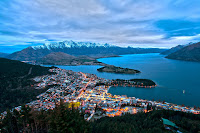One of the many things
I love about New Zealand is our willingness and ability to be crazily eccentric.
So, as we are between
islands, so to speak, let’s look back on some of the things you might find in the South Island and which I hope will amuse you.
 |
| Colac Bay surfer |
West of Invercargill,
is Colac Bay where a surfer statue stands outside the tavern. There was some concern that children climbing
on it might hurt themselves so Southland Council put up a ‘Do Not Climb’ sign.
That’ll work for sure.
Should you be motoring
through Tuatapere, 36km away, don’t drive off the road when you see this:
Tuatapere is the ‘Sausage Capital of the World’ and won a sizzling competition run
by ZM Radio who subsequently erected this delicious banger.
Now all they need is a pile of mash to go with
it.
Te Anau in
Fijordland National Park has spectacular scenery.
 |
| Te Anau |
But also boasts a giant
Takahe standing, unsurprisingly, outside the Bird Sanctuary.
This flightless Rail was thought to be extinct until located in 1948.
It has
special cultural significance to Ngai Tahu, the local Maori tribe who are its kaitiaki (guardians).
In Central Otago gold
country, all you need to do if you want to know the time is look to the hills - and there's a working and accurate clock.
Cromwell is where New
Zealand gets its succulent soft fruits and in Springtime, the blossom trees attract
tourists, especially from Asia.
All year round though, you can see these tasty
fruits displayed as you enter town. Mmmm, mouth-wateringly fruity!
Feeling peckish as
you hit Springfield? Homer Simpson would be in his element here.
 |
| The Springfield Doughut |
Rakaia on the
Canterbury Plains boasts the braided Rakaia River and the longest road and rail
bridges in Aotearoa at 1,750 metres (1.084 miles) long. The river is popular
with anglers for its Salmon, hence this leaping fish.
 |
| That salmon doesn't look to sure about the welcome |
New Zealand loves its odd erections and there are more to come as we move up the North Island.
It's a fundamental part of the Kiwi characte, that we are proud of our local industries and enterprises but don't get too precious about them.
We're always up for a laugh, especially at ourselves.
**************************************************************************************
 |
| Parliament Building nicknamed The Beehive |
We've arrived in well-named Windy Wellington and although this
city, like Nelson, is also a centre for the arts, it has a more avant-garde feel.
Here in the capital, you’ll
find Te Papa Tongarewa, the Museum of New Zealand, filled with precious
things which speak about our history, our present and our future.
Collections include items as diverse as a Tanoa
fai`ava (kava bowl) from Samoa to the paintings of Sir Cedric Morris.
 |
| Springtime 1923 |
Bohemian and fascinating, Cuba Street’s a stage for
performers of all kinds, sculpture included. The Bucket Fountain has been used for
protests; is enhanced with foaming dishwashing liquid on Friday nights and on hot
summer days, part of the whole Cuba
Street experienced is to be splashed by the buckets.
Wellington is also
home to theatre, on and off street and that generates many wonderful
characters, my favourite being the outrageous Constance Craving.
 |
| Constance Craving aka the beautiful Maryanne Cathro |
You’ll find her performing in
various venues here and overseas. “Fabulous darling!”
One last look at the city from the historic Cable Car which will haul us from
bustling Lambton Quay, 612m to Kelburn, where a splendid view of the
city, harbour and surrounding ocean can be marvelled at.
 |
| Historic Wellington Cable Car |
After reachign the top, you can walk back down through
the beautiful Botanic Gardens but don’t forget to visit Space Place the
Planetarium first.
You could spend weeks in Wellington and still not see everything. It's a constantly changing city full of creative people, all living life to the full and never wasting a moment.
And we'll follow their example and set off North - we've still a long way to go before we hit Cape Reinga, just over 1,000km away.

















































